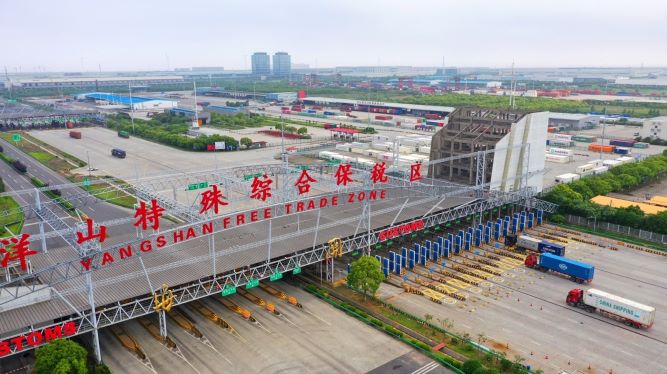China continues to deepen opening-up in financial sector
By Xu Zhifeng, People’s Daily
Yangshan Free Trade Zone in Shanghai’s Lingang Area, a newly launched section of the Shanghai free trade zone is inaugurated on May 16, becoming the only special integrated bonded zone among 151 customs special supervision zones in China. Photo by Ji Haixin/People’s Daily Online
The People’s Bank of China and the State Administration of Foreign Exchange (SAFE) recently announced to abolish the investment quota limits for Qualified Foreign Institutional Investors (QFII) and Renminbi Qualified Foreign Institutional Investors (RQFII).
QFII are also allowed to freely choose in which currency and when they remit money to the country. China will also simplify outward remittance procedures for QFII’s securities investment gains and lift other restrictions.
These measures are believed to further facilitate foreign institutional investors’ participation in the country’s financial market.
China’s QFII program approved the first two foreign institutional investors in 2003, serving as a new window for its opening-up of the financial market. Ever since, the program has been developing in an increasingly open manner.
Apart from the QFII scheme, new channels are constantly being created to open the financial market. China launched the Shanghai-Hong Kong Stock Connect program in 2014, and the Shenzhen-Hong Kong Stock Connect program two years later. The two-way opening-up model enabled deeper integration of China’s financial market into the world, and further expanded the opening-up.
To pursue mutual benefit and common growth is what drives the Chinese financial market to become opener. The QFII scheme generated strong vitality in the past years because it conformed to the general trend of opening-up and achieved win-win results for each party concerned.
The opening-up efforts created important investment opportunities for foreign investors. According to statistics, since the implementation of the QFII and RQFII schemes, more than 400 institutional investors have invested in China’s financial market in this way. The global financial market experienced huge turbulence this year due to the COVID-19 outbreak, but QFII are still confident about investing in China.
Over 200 companies listed on China’s A-share market were newly invested by QFII in Q1, as indicated in the Q1 reports of listed companies. SAFE statistics also showed that in the first quarter, direct investment recorded a net inflow of $14.9 billion. Behind the figures is the optimism of foreign investors about China’s economic prospects.
China’s economy has released multiple positive signals in the first three months this year. The country’s new business models and new driving forces surged against headwind; industrial development demonstrated strong resilience; fundamentals of consumption remained stable; and work resumption was picking up speed. The fundamentals sustaining the sound momentum for China’s stable and long-term economic development are not changed, and the Chinese economy is able to turn crisis into opportunities and ensure long-term stability. This is also why foreign investors are casting “votes of confidence” in China with concrete actions.
China’s financial industry has witnessed increasing openness in its development over the past years, and since this year, the opening-up in the financial sector is no longer limited to the QFII scheme. China has removed the restrictions on foreign equity ratios in security companies and approved joint ventures to conduct bank card clearing business in the country. Besides, a slew of opening-up measures were also rolled out in Beijing and Shanghai. It proves that China’s opening-up is advancing as scheduled, and the steps will not be halted.
It is expected that the accelerating pace of opening-up will further enhance the resilience of the Chinese financial market and bring more dividends to financial consumers and investors. It will also create new opportunities for global investors and help them achieve more extensive and intensive growth.













